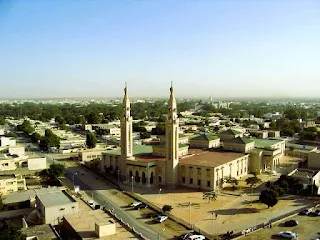Architectural Glory: The Nouakchott Mosque of Mauritania
Exploring the Nouakchott Mosque's Design
At first glance, the Nouakchott Mosque's most prominent feature is its soaring minaret, one of Africa's tallest. This towering structure serves as a call to prayer and a beacon that guides the faithful toward their place of worship. The minaret's height allows the call to prayer, or Adhan, to resonate far and wide, calling the community to come together for their daily prayers and congregational gatherings.
It's common for mosques to be named based on their location, as in the Nouakchott Mosque in Nouakchott, Mauritania. The mosque's design pays homage to the classic elements of Islamic architecture. Like in many Islamic architectural designs, the dominant colors at the Nouakchott Mosque tend to be earthy and neutral tones, with white being a particularly prevalent color. These color choices have cultural and practical significance in Islamic architecture.
Its grand entrance is adorned with intricate geometric patterns and Arabic calligraphy. Inside, the prayer hall boasts an expansive space adorned with ornate arches and columns that evoke a sense of serenity and transcendence. These architectural features are reminiscent of the aesthetics of many historical Islamic monuments, connecting the mosque to a rich heritage of Islamic art and design.
What sets the Nouakchott Mosque apart is its modern approach. The clean lines, minimalist aesthetics, and the use of modern materials like concrete and glass offer a departure from the more traditional design seen in older mosques. This blend of traditional and contemporary design elements creates a striking contrast that captures the essence of Nouakchott's urban landscape while honoring the enduring traditions of Islamic architecture.
Observing five daily prayers is a fundamental mandatory practice and constitutes one of the essential pillars of Islam. The mosque's spaciousness accommodates large congregations, making it an ideal location for Friday Jumu'ah prayers and special Islamic occasions.
The courtyard stretches out before you with its smooth, sun-kissed tiles. Its simplicity is its strength, allowing for a sense of unity and purpose as people gather here for prayer and reflection. The neatly arranged rows of palm trees provide both shade and a touch of greenery, adding to the soothing ambiance.
Surrounding the courtyard is the plaza, a paved area where worshippers and visitors can gather before and after prayers. It's a place of connection and community where individuals engage in quiet conversations, children play, and friends catch up.
The intricate geometric patterns in the plaza's design are a nod to the rich traditions of Islamic art and culture, offering a visual feast for the eyes. The Nouakchott Mosque serves as a center for religious and educational activities, including Quranic studies and Islamic lectures.
The choice of colors in Islamic architecture is deeply rooted in cultural, religious, and climatic considerations.
The Nouakchott Mosque's color palate reflects a reverence for simplicity, purity, and natural beauty while also considering the practical need for keeping the mosque's interior comfortable in hot and sunny regions like Nouakchott, Mauritania. These color choices contribute to the mosque's overall aesthetic and spiritual ambiance, creating an inviting and serene atmosphere.
Due to its symbolic and practical significance, White is a predominant color in many Islamic architectural designs, including the Nouakchott Mosque. White is associated with purity, cleanliness, and simplicity, which align with Islamic values and aesthetics. It symbolizes spiritual purity and the idea of a clean, unadorned heart when approaching prayer. Besides, white reflects sunlight and helps keep the mosque's interior cooler in Mauritania's hot desert climate.
Earthy beige, tan, and brown colors are often used for Islamic architecture's exterior and interior elements. These colors are inspired by the natural environment, particularly the desert landscapes common in many Islamic regions. They blend harmoniously with the surrounding environment and evoke a sense of tranquility and connection to the earth.
While earthy and neutral tones dominate many Islamic architectural designs, the Nouakchott Mosque incorporates accents of green and blue. Green is considered the color of paradise in Islamic tradition, and it represents fertility, life, and renewal. Often seen in decorative tiles and mosaics, blue symbolizes spirituality and heaven. These accent colors add vibrancy and symbolism to the overall design.
The mosque's prominent location and impressive design symbolize the importance of Islam in Mauritanian society and its role in the people's daily lives. It stands as a symbol of Islamic identity and faith in the capital city.







